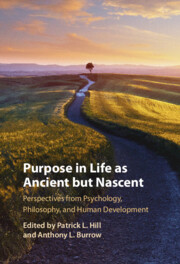 Purpose In Life As Ancient but Nascent
Purpose In Life As Ancient but Nascent Book contents
- Purpose in Life as Ancient but Nascent
- Purpose in Life as Ancient but Nascent
- Copyright page
- Contents
- Figures
- Tables
- Contributors
- Chapter 1 Purpose as an Ancient yet Nascent Construct
- Chapter 2 The Moral Purpose of Wisdom
- Chapter 3 Is Purpose Findable?
- Chapter 4 The Affluence–Purpose Paradox
- Chapter 5 Positive Transitions to Adulthood
- Chapter 6 Undergraduate Students’ Purpose and Persistence in Higher Education
- Chapter 7 How Institutions of Higher Education Support and Thwart Students’ Negotiations of Identity and Self-Direction
- Chapter 8 How to Cultivate Sense of Purpose and Life Engagement
- Chapter 9 You Live, You Learn
- Chapter 10 Seizing the Power of Religion to Shape Purpose
- Chapter 11 Religious Faith and Life Purpose
- Chapter 12 Where Does Purpose Belong in Well-Being Theory?
- Chapter 13 Self-Compassion and Ikigai
- Chapter 14 Purpose as a Timeless Pursuit
- Index
- References
Chapter 12 - Where Does Purpose Belong in Well-Being Theory?
Published online by Cambridge University Press: 31 October 2025
- Purpose in Life as Ancient but Nascent
- Purpose in Life as Ancient but Nascent
- Copyright page
- Contents
- Figures
- Tables
- Contributors
- Chapter 1 Purpose as an Ancient yet Nascent Construct
- Chapter 2 The Moral Purpose of Wisdom
- Chapter 3 Is Purpose Findable?
- Chapter 4 The Affluence–Purpose Paradox
- Chapter 5 Positive Transitions to Adulthood
- Chapter 6 Undergraduate Students’ Purpose and Persistence in Higher Education
- Chapter 7 How Institutions of Higher Education Support and Thwart Students’ Negotiations of Identity and Self-Direction
- Chapter 8 How to Cultivate Sense of Purpose and Life Engagement
- Chapter 9 You Live, You Learn
- Chapter 10 Seizing the Power of Religion to Shape Purpose
- Chapter 11 Religious Faith and Life Purpose
- Chapter 12 Where Does Purpose Belong in Well-Being Theory?
- Chapter 13 Self-Compassion and Ikigai
- Chapter 14 Purpose as a Timeless Pursuit
- Index
- References
Summary
Is purpose a cause, consequence, correlate, or component of well-being? Sense of purpose can be understood as the extent to which one feels that they have personally meaningful goals and directions guiding them through life. Because models of well-being differ in how they conceptualize what it means to be psychologically well, purpose is treated differently across these frameworks. In this chapter, we begin by considering how purpose fits in various well-being theories, including philosophical schools of thought (Liking, Wanting, and Needing theories), contemporary theoretical and measurement models (e.g., subjective well-being, Value Fulfillment Theory, Ryff’s psychological well-being, self-determination theory, Positive emotion, Engagement, Relationships, Meaning, and Accomplishments, and other factors such as health (PERMA+)), and mechanistic models that seek the synthesize across multiple approaches (e.g., Engine Model of Well-Being, Eudaimonic Activity Model). We conclude by answering the question proposed in the title of this chapter, “Where does purpose belong in well-being theory?”, and by offering specific recommendations for purpose and well-being researchers.
Information
- Type
- Chapter
- Information
- Purpose In Life As Ancient but NascentPerspectives from Psychology, Philosophy, and Human Development, pp. 254 - 267Publisher: Cambridge University PressPrint publication year: 2025
References
Accessibility standard: WCAG 2.2 AAA
Why this information is here
This section outlines the accessibility features of this content - including support for screen readers, full keyboard navigation and high-contrast display options. This may not be relevant for you.Accessibility Information
Content Navigation
Allows you to navigate directly to chapters, sections, or non‐text items through a linked table of contents, reducing the need for extensive scrolling.
Provides an interactive index, letting you go straight to where a term or subject appears in the text without manual searching.
Reading Order & Textual Equivalents
You will encounter all content (including footnotes, captions, etc.) in a clear, sequential flow, making it easier to follow with assistive tools like screen readers.
You get concise descriptions (for images, charts, or media clips), ensuring you do not miss crucial information when visual or audio elements are not accessible.
You get more than just short alt text: you have comprehensive text equivalents, transcripts, captions, or audio descriptions for substantial non‐text content, which is especially helpful for complex visuals or multimedia.
You can access graphs or charts in a text or tabular format, so you are not excluded if you cannot process visual displays.
Visual Accessibility
You will still understand key ideas or prompts without relying solely on colour, which is especially helpful if you have colour vision deficiencies.
You benefit from high‐contrast text, which improves legibility if you have low vision or if you are reading in less‐than‐ideal lighting conditions.